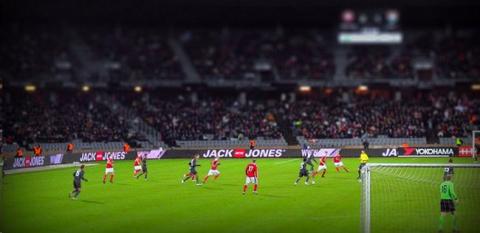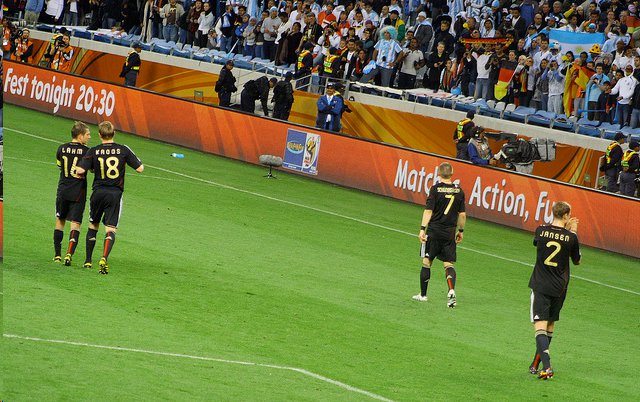Et Tu, Etas Unis? Soccer and the American Dream

"Bastards!" A half-centurion barks the invective like a downtown schizophrenic in heat. The curse rings for a nanosecond, then evaporates in the midday sun. Our subject shoulders his sports bag and huffs toward the parking lot, his body taut and stooped with rage.
"Try to not aim for the f--king post next time, yeah?" a septuagenarian yells after the defeated. "We'll see you at Bozos next week, Tommy?" The successive inquiry belongs to a grinning 63-year-old who could easily pass as Terrence from Entourage. He gets his desired response: Our subject raises his middle finger until he disappears behind a copse of evergreens. A car door slams, an engine revs and tires screech in the manner of someone who enjoys a good Hollywood exit. Those remaining chuckle and exchange their boots for flats while toweling off sweat rivulets and loose grass. I recline beside an exhausted Peruvian who offers an unsolicited answer to my internal question: Bozos?
"It's because we play like bozos. You make a mistake, it's OK. We already knew you were a Bozo because you play with us."
I expressed incredulity that my companion, in all his Peruvian bombast, would submit to the moniker Bozo.
"I'm Peruvian, man. We don't make mistakes."
The Bozos, young and old, gather weekly to play on a local pitch, a tradition that remains unsullied for over 30 years. In Italy, Ethiopia, or Argentina, weekly gatherings for "footie" congregate in every city, town, and prison. But this is the United States, home of Lebron James and Tom Brady and Miguel Cabrera. This is the same country where soccer celebrates its 100th year in utero. The Bozos are an anomaly, a forgettable eccentricity only replicated by deviants across the nation.
We should care about the Bozos and their passion. After all, soccer, both professionally and recreationally, is the fastest-growing sport in America. As soccer's popularity increases, growing minority populations (especially the fast-growing Hispanic population) represent a large pro-soccer demographic — but America fails to match their zeal. Not in the way other nations do. It's an obstacle U.S. soccer executives have yet to maneuver around. And so, U.S. soccer's recent efforts to reshape the sport's image have reached an impasse where method reigns and passion falters.
Pressure, Cover, Balance
We find ourselves at a sidewalk bar with an already soused Men's National Team trainer before his team handles Panama 2-0 at Qwest Field in Seattle (home to the Seahawks and Sounders and poorly laid sod). The bar is packed with U.S. fans in red and white stripes. They're draining Bud Light, flirting awkwardly, and comparing commemorative scarves in typical pre-game aimlessness. My father, en route to a handicap spot (where he'll whip out his late father's 2008 handicap parking permit), is meeting me at the stadium, so I expedite my interview with my pickled partner.
"Is Jürgen Klinsmann the answer?" I ask. He shrugs a non-verbal: We'll see. The trainer is reserving judgment until Klinsmann unveils his hand next year in Brazil. Come the World Cup, Klinsmann's contract-mandated control over U.S. youth soccer development and strict coaching regimen for the USMNT will face the scrutiny of Dan Flynn, the U.S. soccer administration and the USMNT coaching staff. He'll square up against the best in the world while all of this transpires, but that's familiar territory for the ex-German national player and ex-Die Mannschaft team coach. If Klinsmann flops, he joins the unremarkable batch of coaches who were unable to pull American soccer out of its culture of mediocrity. However, if his team is a smash American soccer will generate serious attention in the right Nielsen demographics.
"Is the restructuring of American Youth Soccer working?" I ask. He says: “Not yet.” The new Landon Donavons aren't emerging. The model is hopelessly inverted. There's still no passion, even at the national level.
"Are we modeling ourselves after the wrong organizations? Are we using the last decade's technology for current and future results?" I ask. He says: It doesn't matter what methods we use, American soccer doesn't possess the desire that spins talent into greatness. We need the madness first, then the method.
"That was a clear signal for all of Europe."
For the unaware, a Champion's League title game first occurred this past May: two German teams went head-to-head for the coveted CL shield. This all-Teutonic showdown solidified Germany's evolution into a football leviathan, but it was their decisive handling of Spain's two powerhouses - Real Madrid and Barcelona - that effectively measured, cut, and laid out the red carpet for the new European kings. In Europe the signal is clear: Germany is ready for the international stage.
It wasn't always beer and lederhosen for the Germans.
In 2002, German football watched a significant chunk of their funding disappear with the collapse of popular broadcasting company Kirch TV, the source of the Bundesliga's broadcasting revenue. Against conventional logic, German club owners began severing expensive contracts with frugal gusto. The speculate-for-success model (which the Bundesliga, Premier League, and majority of top-tier national football organizations abided by at the time) requires a healthy flow of money to cajole and woo established international stars. Cognizant that the money to compete with leagues flush with oil sheiks and American football owners simply isn't there, Germany turned inward, promoting and investing in untested local talents instead of scouring the globe for successful and expensive players to add to their ranks. The local focus proved tremendously successful (and cheap).

To encourage sustainability, Germany overhauled their football model from the ground up, designing youth development to feed the Bundesliga and for the Bundesliga to feed the national team. Germany, under the leadership of the then national team coach Jürgen Klinsmann and his assistant-now-manager Joachim Löw, began planning for the future instead of spending for the now.
The success wasn't immediate. Germany pulled itself from finishing in the bottom of the 2000 Euros group stage to contend for the World Cup title against Brazil in 2002 (a match-up many hope and predict to see in 2014), a first round exit in the Euros in 2004, a third place finish in the 2006 World Cup, a second place finish in 2008 Euros, a third place finish in the 2010 World Cup, a third place finish in the 2012 Euros, as well as positioning their club teams in contention for the coveted annual Champions League trophy. This past year, the CL title game was an all-German contest, heralding Germany as the new face of football.
Paint us like one of your German success stories, Klinsy
It's no secret that the United States courted Klinsmann in 2006 like a friend-zoned middle schooler. Klinsmann wanted total control and the USSF wasn't quite ready to relinquish, so Bob Bradley became the interim manager until Klinsmann, or the USSF, yielded. Bradley retained his position long enough to watch his son and USMNT lose to Ghana in World Cup OT a few degrees before the final stage. Meanwhile, the USSF was sending Klinsmann fruit baskets decorated with Ritter Sport chocolate and contract negotiations. Klinsmann re-entered negotiations with the USSF, got what he wanted, and omitted the umlaut as he penned his signature. Bob Bradley (one of the more successful USMNT coaches) was out, ousted by the USSF's darling after only one vuvuzela-ridden World Cup term (perhaps Michael Bradley will avenge his father's Ghana loss in 2034).
After bedding Klinsmann, U.S. Soccer issued this demand: Paint us like one of your German success stories, Klinsy. To ensure American assimilation into Germanic methods, the USSF threw a significant chunk of Hamiltons at the German Architect, amended the managerial contract to his absolute-power-and-full-control demands, and provided him with enough power and staff to resuscitate Detroit and perhaps cure American soccer malaise. And, for his part, Klinsmann has laid results at the feet of American slippers. As of writing this sentence, the United States Men's National Team is in the midst of their longest-winning streak and hold the longest active winning streak in FIFA. This current rash of success has sent the once dissenting public into swoons for Herr Klinsmann and his ever-shifting rosters and formations. Perhaps we're swooning prematurely.
As any Gonzaga alumni can (but won't) attest to, a glut of wins in a weak conference doesn't translate to a dominant performance in the Big Dance. The USMNT can trounce CONCACAF (Confederation of North, Central American and Caribbean Association Football) like Romney 2012, but it's meaningless when pitted against actual World Cup contenders. American nationals will only know their team's true mettle when they play a World Cup contender in top form, and because no competitor takes the Yankees seriously, the fans never get to watch a fully unleashed [Bastian] Schweinsteiger send a curling ball for wispy, phantom-like Thomas Müller to nod the ball past an outstretched and already angry Tim Howard. To quote soccer columnist Roger Bennett: "The World Cup is everything here [in America] because there is nothing else to mark ourselves against, and the problem is, there is such a thin line between success and failure."
Klinsmann, even without Joachim Löw, is no fool. Success in the Hexagonal and against a weakened El Tri is great for media love and vigorous arm-pumpings paired with bubbling praise from grinning USSF executives. But when Klinsmann is resting in savasana next to Eddie Johnson, he must be acutely aware that he is doing more with less, that his team's success is simply an extension of his wit and wile coupled with the relatively low RPI of the USMNT's current schedule. And so, Klinsmann has his staff scouring the globe for dual citizenship talents, eschewing the possibility of America's nascent academy program churning out the next Alexi Lalas. Why? Because the United States development program isn't attracting the most qualified candidates.
Ducks in A Row
Right now, a future striker for Michael Bradley's theoretical World Cup 2034 side is staring at his all-too-real umbilical cord and kicking and screaming for the womb. When he's five, he'll begin to learn the contours of a soccer ball and weave his way through his peers game after game. As he reaches age 10, various licensed coaches from an academy development program will have instructed him on various tactical and fundamental skill-sets and turned him into a strong, knowledgeable striker with a good eye for the net. He'll enter a respected MLS academy and develop a field sense (positioning, decision-making and linking within formation).

Soon enough, he'll adapt to any formation and exhibit team leadership even though he's two years his teammates' junior. He'll gain recognition by debuting at age 17 in the MLS and string together a flurry of goals over the next three years. Then he'll win the Golden Boot in the U-20 World Cup and soon find himself subbed on for the USMNT in the 73rd minute during a friendly against the Democratic-Socialist-Republic of North X North-East Korea and score in the 82nd with an absolute cracker of a shot. After the game, coach Michael Bradley will comment on how the wonderful academies in the U.S. cultivate local players such as our subject before plugging the new Nike Steam boots. This is the stuff that USSF dreams are made of.
Since 2012, every MLS team maintains a free and full-functioning academy with moderate success. Each academy sources from local clubs, showcases, and camps, whisking away the most promising talents and training them for future MLS contracts within their respective organizations. As a model, the U.S. academies bear a considerable resemblance to the German academies, sans the $300 million euros Germany invests in youth development annually and the ideological devotion to a dominant German national squad. All that and some comparable results.
Appropriating the German model of youth development photographs well, but superimposing a proven model from a soccer-centric country onto an America that offers myopia of opportunities for athletes proves a bit crunchy. Soccer simply doesn't shine like basketball, football, or even baseball — yet. Consequently, the academies don't see the athleticism that would thrive under their tutelage. Not when hand-eye coordination pays more.
How Much You Got?
Lack of athleticism aside, where American soccer development really suffers originates from youth soccer's pay-to-play model. Since many players aren't immediate academy caliber, select clubs offer a sanctuary for the snubbed to actualize. Within the select club system, a once middling prospect may evolve into an outright phenom. And through the bevy of tournaments, camps, or coaching connections the clubs offer, an emerging talent receives the attention necessary to merit a tryout with the academy. Unfortunately, all of these attention-garnering mediums cost money -- quite a bit of money.
Not only are there club fees, players have to have health insurance to even step on the field. Since health insurance isn't exactly a top priority for poorer families (and repealing the Affordable Care Act is more fashionable than Hilary Clinton's pantsuits), competition for coveted academy spots remains the domain of the predominantly white bourgeoisie.
Not to knock my own demographic, but when it comes to coaching, well-mannered bourgeoisie hardly cut the mustard.
"These kids," to quote a Seattle-based coaching director, "are too damn coachable." While coachable kids tend to do wonders for a coach's ego and function quite well in the business world, their respectfulness undermines individual creativity on the pitch. Instead of trying something on their own, the coachable types wait for and abide by the coach's instructions. Americans idealize timorous obedience, but soccer is a player's game that demands great players to think for themselves. Sadly, the majority of the bourgeoisie demographic has obedience bred into them like Dockers and plaid shirts.

Education, An Unlikely Foe
Sunil Gulati, noted economist and current president of the USSF, speaks to the realities facing American youth soccer development:
"We're not going to re-create the beaches of Copacabana and we're not going to create a ghetto somewhere else where kids are going to learn it in the street . . . American society is different. The role of education is extraordinarily important in the United States . . . It's very different than it is in England or Brazil, or in Italy where a gifted 17-year-old isn't thinking about the University of Rome, he's thinking about playing for A.C. Milan," Gulati said. "If a kid is choosing between a place like Columbia, that's a different decision from somebody who doesn't have 1400 SATs and might be thinking about another alternative. Opportunity cost, as we would say in Principles of Economics."
The importance of education creates an unlikely dilemma for potential soccer players. For families living under the poverty line, education often represents the pathway to a higher socioeconomic status. When education is the only priority, any time spent in pursuit of extracurricular activities is better spent before an open Prentice Hall. Conversely, for those with money and connections, pursuing a career in soccer isn't nearly as financially feasible as attending Columbia and getting your Masters in business. Education forms a bracket above the lower class and beneath the upper class, reinforcing the white, middle-class standard.
The Great Minority-Majority Hope
After collating the data compiled from the 2012 census, analysts found a nascent cultural shift in the five and younger demographic. Due to an aging white population, increased immigration, and higher birth rates in minorities, non-Hispanic whites are projected to lose their majority status in the [less than] five-year category and rank as a minority by the end of 2043. The implications of this transition are far-reaching, especially from a sociocultural perspective.
A new majority means a new dominant culture. Univision, the Hispanic station known for its telenovelas and shameless self-adulation, is a tremendous hit among the most important age demographic, 18-49. And even though it broadcasts solely in Spanish, Univision appears to have no trouble appealing to non-Spanish viewers. Ethnicity alone doesn't account for Univision's prowess. The broadcasting station's approach to news, its avoidance of ostensible political agenda, and promotion of uncontrived cultural diversity entices Hispanic and non-Hispanic viewers who grow weary of basic cable's unimaginative formulas for ratings. Mixed into their assemblage of news and sitcom bric-a-brac, Univision specializes in one sport: fútbol. Not only is Univision one of the sole broadcasters of Mexican fútbol - at the national and league level - it also owns the rights to the most expensive broadcasting contract of the 2013 MLS season, paying more than ESPN and NBC to carry the lion's share of this season's matches.
Over a fifth of the new minority-majority lives under the poverty line and a large portion are barely above it. The demographic contains a significant amount of soccer fanatics, but American club soccer isn't prepared to cater to their reduced pocketbooks. As of right now, it's an opportunity only available to those with an extra couple grand to spend annually. And depending on the quality of your team, that cost may be higher. If club soccer and the chance to enter the academy is an opportunity and opportunities are the lifeblood of the poor or immigrant, American club soccer is denying obvious prospects with desire to succeed from entering the club-academy system. This is the crux of the American youth development quandary: the pay-to-play system is inverted, denying those that possess the ardor to make it to the top and welcoming the coachable kids with financially dependable parents.
America | Germany
In 2004, when the German team realized they were depending on an aging Michael Ballack and Oliver Kahn, they created a 10-year plan to revive the German national team for 2014 World Cup dominance. America isn't at the point of revivification, we want to progress to the elite stage. And so, we've instituted our own 10-year plan, brought in the German Architect, and filled the academy ranks. The sport is expanding faster than any sport in the U.S., and many media types project soccer to be second to only American football. Yes, we've built the methods for success.
But where is the madness? ¿Dónde está el corazón?
It's like a Halloween carnival. The rides are turned on, the haunted house is sublimely spookified, and the carnies are reclining on wooden chairs, nonchalantly tossing a ring up in the air. An empty carousel rotates with a dirgeful calliope.
Where are all the screaming kids?
Author Bio:
Tyler Huggins is a contributing writer at Highbrow Magazine.
Photos: Bjorn Giesenbauer; The US Army; Texas Tongs; Wespont (Flickr, Creative Commons).






























































































































































































































































































































